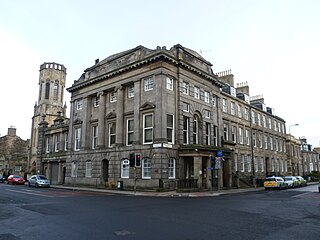
Ayrshire is a historic county and registration county, in south-west Scotland, located on the shores of the Firth of Clyde. The lieutenancy area of Ayrshire and Arran covers the entirety of the historic county as well as the island of Arran, formerly part of the historic county of Buteshire. Its principal towns include Ayr, Kilmarnock and Irvine and it borders the counties of Renfrewshire and Lanarkshire to the north-east, Dumfriesshire to the south-east, and Kirkcudbrightshire and Wigtownshire to the south. Like many other counties of Scotland, it currently has no administrative function, instead being sub-divided into the council areas of East Ayrshire, North Ayrshire and South Ayrshire. It has a population of approximately 366,800.

North Ayrshire is one of 32 council areas in Scotland. The council area borders Inverclyde to the north, Renfrewshire and East Renfrewshire to the northeast, and East Ayrshire and South Ayrshire to the east and south respectively. The local authority is North Ayrshire Council, formed in 1996 with the same boundaries as the district of Cunninghame which existed from 1975 to 1996.

Port Glasgow is the second-largest town in the Inverclyde council area of Scotland. The population according to the 1991 census for Port Glasgow was 19,426 persons and in the 2001 census was 16,617 persons. The most recent census in 2011 states that the population has declined to 15,414. It is located immediately to the east of Greenock and was previously a burgh in the county of Renfrewshire.

Cunninghame is a former comital district of Scotland and also a district of the Strathclyde Region from 1975 to 1996.

Troon is a town and sea port in South Ayrshire, situated on the west coast of Ayrshire in Scotland, about eight miles north of Ayr and three miles northwest of Glasgow Prestwick Airport. Troon has a port with ferry and freight services, and a yacht marina. Up until January 2016, P&O operated a seasonal ferry service to Larne. In May 2006, a ferry service to Campbeltown was added, although this was withdrawn the following year. Since March 2024, Caledonian MacBrayne have operated a ferry service to Brodick on the Isle of Arran.

Saltcoats is a town on the west coast of North Ayrshire, Scotland. The name is derived from the town's earliest industry when salt was harvested from the sea water of the Firth of Clyde, carried out in small cottages along the shore. It is part of the 'Three Towns' conurbation along with Ardrossan and Stevenston and is the third largest town in North Ayrshire.

Ardrossan is a town on the North Ayrshire coast in southwestern Scotland. The town has a population of 10,670 and forms part of a conurbation with Saltcoats and Stevenston known as the 'Three Towns'. Ardrossan is located on the east shore of the Firth of Clyde.

Stagecoach West Scotland is an operating region of Stagecoach UK Bus, comprising Western Buses Ltd based in Ayr, Scotland.

West Kilbride is a village and historic parish in North Ayrshire, Scotland, on the west coast by the Firth of Clyde, looking across the Firth of Clyde to Goat Fell and the Isle of Arran. West Kilbride and adjoining districts of Seamill and Portencross are generally considered to be a small town, having a combined population of 4,393 at the 2001 census.
Bute and Northern Ayrshire was a county constituency of the House of Commons of the Parliament of the United Kingdom from 1918 to 1983. It elected one Member of Parliament (MP) by the first past the post voting system.

Saltcoats railway station is a railway station serving the town of Saltcoats, North Ayrshire, Scotland. The station is managed by ScotRail and is on the Ayrshire Coast Line.

The Old Town Hall is a municipal building in Queen Charlotte Street, Leith, Scotland. The old town hall, which was the meeting place of Leith Burgh Council, is now used as a police station. It is a Category A listed building.

Troon Town Hall is a municipal building in Ayr Street, Troon, Scotland. The structure, which serves as the meeting place of Troon Community Council, is a Category B listed building.

Saltcoats Town Hall is a municipal building in Countess Street, Saltcoats, North Ayrshire, Scotland. The building, which is used by North Ayrshire Council as hub for the delivery of local services, is a Category B listed building.
Elections to North Ayrshire Council took place on 5 May 2022 on the same day as the 31 other Scottish local government elections. As with other Scottish council elections, it was held using single transferable vote (STV) – a form of proportional representation – in which multiple candidates are elected in each ward and voters rank candidates in order of preference.
Ardrossan is one of the nine electoral wards of North Ayrshire Council. Created in 2022, the ward elects three councillors using the single transferable vote electoral system and covers an area with a population of 10,359 people.

Ardrossan and Arran was one of the 10 wards used to elect members of North Ayrshire Council. Created in 2007 following the Fourth Statutory Reviews of Electoral Arrangements, the ward elected three councillors using the single transferable vote electoral system. Originally a four-member ward, Ardrossan and Arran was reduced in size following a boundary review ahead of the 2017 election. As a result of the Islands (Scotland) Act 2018, the ward was abolished in 2022.

New Cumnock Town Hall is a municipal building in Castle, New Cumnock, East Ayrshire, Scotland. The structure, which is used as a community events venue, is a Category C listed building.

Darvel Town Hall is a municipal building in West Main Street, Darvel, East Ayrshire, Scotland. The structure, which is used as a library and a community events venue, is a Category B listed building.

Ardrossan Civic Centre is a municipal building in Glasgow Street in Ardrossan, a town in North Ayrshire, Scotland. The building, which was previously the offices and meeting place of Ardrossan Burgh Council, is currently used as a masonic hall.


















